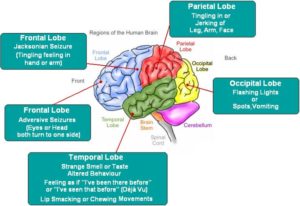What is epilepsy?
Most people with epilepsy are otherwise healthy; as long as it’s well controlled like most other diseases. A seizure is a physical manifestation of paroxysmal and abnormal electrical firing of neurons in the brain. Think of it as numerous voltage (hyperexcitability of neurons) going throughout the brain meaning brain waves going in all directions with the brain saying its too much activity going through my organ and can’t think normally; instead the brain goes through a shock. In simpler terms the brain is getting too much brain wave excitability for the organ to register in what to do causing the brain to go into a type of a seizure.
When the seizure occurs there is a decrease in oxygen since the brain isn’t capable to send messages during the seizure. The problem it too much electrical stimulation is happening in the brain causing the type of seizure to come on. If the seizure continues to repeat one right after another the person is in status epilepticus and if the seizures do not stop the person can lead to a neuronal death; like John Travolta’s son who died of this for example.
The term seizure disorder may refer to any number of conditions that result in such a paroxysmal electrical discharge. These conditions could be metabolic or structural in nature.
For example, if a metabolic condition this could be “Canavan disease” which is primarily a disease of demyelination. Your myelin sheath that protects and insulates the nerves is being destroyed and can cause a seizure as one of the symptoms.
*Another example being metabolic is thought to be caused by brain acetate deficiency resulting from a defect of N–acetylaspartic acid (NAA) catabolism (meaning breakdown is occurring). Accumulation of NAA, a compound thought to be responsible for maintaining cerebral fluid balance, can lead to cerebral edema and neurological injury, like a seizure as one symptoms of the disease.
*Sometimes there is a known cause and than there is just idiopathic, unknown cause for the epilepsy which if starts in childhood can resolve by the child growing out it, like in petite mal seizures but other times that is not the case and goes into motor/focal or grand mal that is permanent so the individual needs Rx for life.
Remember, not all seizures are due to epilepsy. Other conditions that can look like epilepsy include fainting, or very low blood sugar in some people being treated for diabetes.
Remember, etiology (the cause) of Epilepsy can be generally a sign of underlying pathology involving the brain–knowing the cause. To find this out diagnostic tooling be a neurologist who specializes in epilepsy is the best resource to go to. The epilepsy may be the first sign of a nervous system disease (ex. Brain tumor), or it may be a sign of a systemic or metabolic derangement. Where the treatment may be able to resolve the seizure symptom completely where this wasn’t a seizure disorder or epilepsy but just a symptom due to another disorder that may be 100% cured, like a operable tumor removed surgically from the brain.
Facts and Statistics on Seizures:
- Most seizures happen suddenly without warning, last a short time (a few seconds or minutes) and stop by themselves.
- Seizures can be different for each person.
- Just knowing that someone has epilepsy does not tell you what their epilepsy is like, or what seizures they have.
- Calling seizures ‘major’ or ‘minor’ does not tell you what happens to the person during the seizure. The names of seizures used on this page describe what happens during the seizure.
- Some people have more than one type of seizure, or their seizures may not fit clearly into the types described on this page. But even if someone’s seizures are unique, they usually follow the same pattern each time they happen.
- Not all seizures involve convulsions (jerking or shaking movements). Some people seem vacant, wander around or are confused during a seizure.
- Some people have seizures when they are awake, called ‘awake seizures’. Some people have seizures while they are asleep, called ‘asleep seizures’ (or ‘nocturnal seizures’). The names ‘awake’ and ‘asleep’ do not explain the type of seizures, only when they happen.
- Injuries can happen during seizures, but many people don’t hurt themselves and don’t need to go to hospital or see a doctor.
Check out Part II tomorrow!

